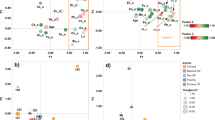Summary
A practical application of urinary 2-ethoxyacetic acid (EAA) to assess occupational exposure to 2-ethoxyethyl acetate (EGEE-Ac) during a large format silk-screening operation is described. Industrial hygiene air monitoring of employees of a silk-screen shop producing large aircraft interior panel coverings revealed a broad range of exposures to EGEE-Ac. Time weighted exposures averaged 12 ppm (range 2.9–34 ppm) in press operators during production press runs, exceeding the 5 ppm Washington State permissible exposure limit. Employees were instructed to use organic vapor respirators until engineering controls could be developed. Urinary monitoring of EAA was conducted on 30 employees by the company medical department to aid in exposure risk assessment and to assess compliance. Results obtained ranged from 1.1–27 mg EAA/g creatinine which compares favorably with the proposed Biological Exposure Index (BEI) of 100 mg EAA/g creatinine. Results of representative air and biological monitoring, and observations of work practices for different exposure groups indicated that inhalation exposure was the predominant route of exposure. Follow-up testing to assess the efficacy of a newly installed ventilation upgrade is planned.
Similar content being viewed by others
References
ACGIH (1992) 1992–1993 Threshold limit values for chemical substances and physical agents and biological exposure indices. American Conference of Government 1 Industrial Hygienists, Cincinnati, OH
Angerer J, Lichterbrek E, Begerow J, Jekel S, and Lehnert G (1990) Occupational chronic exposure to organic solvents: XIII Glycolether exposure during the production of varnishes. Int Arch Occup Environ Health 62:123–126
Begerow J, Angerer J (1990) Improved method for the determination of urinary ethoxyacetic acid by capillary gas chromatography with electron-capture detection. Fresenius Z Anal Chem 366:42–43
Dugard PH, Walker M, Mawdsley SJ, Scott RC (1984) Absorption of some glycol ethers through human skin in vitro. Environ Health Perspect 57:193–197
Groeseneken DH, Veulemans H, Masschelein R, Van Vlem E (1989) An improved method for the determination in urine of alkoxyacetic acids. Int Arch Occup Environ Health 61:249–254
Groeseneken DH, Veulemans H, Masschelein R, Van Vlem E (1987) Ethoxyacetic acid: a metabolite of ethylene glycol monoethyl ether acetate in man. Br J Ind Med 44 488–493
Johanson G (1988) Aspects of biological monitoring of exposure to glycol ethers. Toxicol Lett 43:5–21
Johanson G (1989) Analysis of ethylene glycol ether metabolites in urine by extractive alkylation and electron-capture gas chromatography. Arch Toxicol 63:107–111
NIOSH (1984) Manual of analytical methods. 3rd ed, US Department of Health and Human Services, Public Health Service, Centers for Disease Control, National Institute of Occupational Safety and Health, DHHS (NIOSH) Publication No 84-100. Method 1450, Cincinnati, OH
NIOSH (1991) Criteria for a recommended standard: Occupational exposure to ethylene glycol monomethyl ether, ethylene glycol monoethyl ether, and their acetates. US Department of Health and Human Services, Centers for Disease Control, National Institute for Occupational Safety and Health, DHHS (N10SH) Publication No.91-119, Cincinnati, OH
Smallwood AW, DeBord K, Burg J, Moseley C, Lowry L (1988) Determination of urinary 2-ethoxyacetic acid as an indicator of occupational exposure to 2-ethoxyacetic acid. Appl Ind Hyg 3:47–50
Veulemans H, Groeseneken D, Masschelein R, Van Vlem E (1987) Field study of the urinary excretion of ethoxyacetic acid during repeated daily exposure to the ethyl ether of ethylene glycol and the ethyl ether of ethylene glycol acetate. Scand J Work Environ Health 13:239–242
Author information
Authors and Affiliations
Rights and permissions
About this article
Cite this article
Lowry, L.K., Stumpp, D.A., Orbaugh, C. et al. Applications of biological monitoring in occupational health practice: Practical application of urinary 2-ethoxyacetic acid to assess exposure to 2-ethoxyethyl acetate in large format silk-screening operations. Int. Arch Occup Environ Heath 65 (Suppl 1), S47–S51 (1993). https://doi.org/10.1007/BF00381307
Issue Date:
DOI: https://doi.org/10.1007/BF00381307




